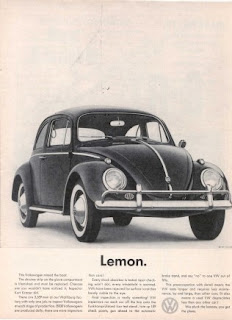The Volkswagen Beetle is one of the most iconic vehicles
ever created. Though it has gone through many revivals and recent speculations
of its discontinuation, the Beetle was once the best-selling
car ever and remains one of VW’s most popular models.
Despite its small size, it had a big hand in changing the
face of advertising as we know it. Here is the story behind VW’s “Think Small”
campaign that helped the German-made Beetle become an American icon.
The First Beetles
The idea of the Beetle was conceived in 1931, when
automotive engineer Ferdinand Porsche and motorcycle manufacturer Zündapp
developed the Porsche Type 12, or “Auto für Jedermann” (“Car for Everyone”).
Two years later, Adolf Hitler commissioned Porsche to develop a “people’s car”
(“Volkswagen” in German) that could seat a family of five. The first prototype
was created in 1935, featuring the distinctive round shape and air-cooled,
rear-mounted engine of the classic Beetle.
Although designed in the 1930s, the vehicle that would
become the Beetle would not be mass produced until after World War II. It was
marketed as the Volkswagen, with later models designated based on their engine
displacement.
As part of the Allied
industrial plans for German industry, the Volkswagen factory was handed
over to British control in 1945. However, no British car manufacturer was
interested in the factory and instead, the government used it to build cars for
the Army. By 1946, the factory was producing 1,000 cars per month.
Anti-German sentiment remained strong after the war, so
export sales were slow at first. The first VW was exported to the U.S. in 1950,
and Volkswagen
of America was formed in 1955 – the same year the one-millionth Beetle was
produced in Germany. This led to the establishment of multiple VW dealerships
and the Beetle’s growth in popularity stateside.
"The Ad That Changed Advertising"
In the late 1950s, American automakers were gearing up to
release their own small cars after witnessing Volkswagen’s success. To head off
this threat, VW sent German businessman Carl Hahn to the U.S. to advertise the
company’s vehicles.
In 1959, VW signed a contract with advertising agency Doyle Dane Bernbach (DDB) worth $600,000 – a minuscule amount compared to the ad spending of other car manufacturers. Instead of trying to promote the Volkswagen as an American vehicle, DDB took a more honest approach, resulting in an ad that looked much different than traditional car ads of the time.
The headline, “Think Small,” and three columns of copy were
set in a sans-serif typeface, rather than the serif fonts used in most ads. The
Volkswagen logo’s positioning between the second and third columns made the ad
feel untraditional. A simple photo of the vehicle was used instead of a fancy
illustration. The entire ad was printed in black and white because of VW’s
limited budget, which created a striking contrast to the colorful pages of Life
Magazine, where it first appeared.
The “Think Small” ad and the many that followed marked a big
shift in the advertising landscape, as seen on the AMC original series Mad Men. It was no longer seen as
necessary to talk down to consumers. Instead, being honest about a car’s
appearance and features became a big selling point. Volkswagen’s ads also
challenged the pressure of consumerism and helped Americans feel comfortable
with not needing to have the latest and greatest.
Volkswagen Ads Today
Volkswagen’s tradition of honest, simple ads continues
today. DDB produces print and television ads for VW that are visually appealing
and challenge the viewer to think differently about modern vehicles and the
automotive industry. As a result, the Beetle remains one of the most popular
vehicles ever created.
Find Your Dream Car at Neil Huffman Volkswagen in Louisville, KY
Thanks in no small part to its clever advertising and award-winning
vehicles, Volkswagen is a mainstay of the American automaker landscape. If
you want to join the millions of Americans who drive a VW, browse the large inventory of new vehicles, including many 2019 models, at Neil Huffman
Volkswagen. We offer incredible savings and two years of complimentary
maintenance with all vehicle purchases.


Comments
Post a Comment